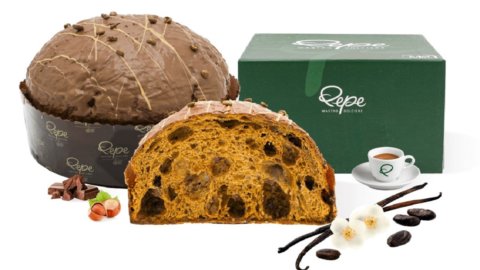It is a virtual embrace between North and South that Panettone Giuseppe Pepe, member of the Academy of Masters of Mother Yeast and Italian Panettone, and owner with the brothers Prisco and Anna of the great pastry shop of Sant'Egidio di Monte Albino, in the province of Salerno, launches to give flavor to the lunches of the Christmas holidays. Two raw materials are the protagonists of his panettone: coffee and gianduia, two names that evoke the flavours, history and traditions of Piedmont and Campania.
The creation of gianduia, ancestor of Nutella, is attributed to Turin pastry chefs in 1806, which replaced a part of the by now very expensive cocoa with the cheaper tonda gentile hazelnut from the Langhe: in fact, the economic blockade ordered by Napoleon for the products of British industry and its colonies which remained in force until 1813, had made it difficult to find some cocoa.
Gianduja, ancestor of Nutella, invented by Piedmontese pastry chefs after the blockade of cocoa imposed by Napoleon
It was then the chocolatier Michele Prochet, in 1852 entered into partnership with Caffarel, to improve the dough by toasting the hazelnuts and grinding them finely. According to what has been handed down, the chocolate destined to mark the history of Piedmontese pastry was born from a "spoon stroke" skilfully given to this soft dough. Thus was born the Gianduiotto with its typical shape, which will be presented as the first wrapped chocolate on the occasion of the Carnival of 1865, distributed by the popular mask of Turin, Gianduja which thus gave its name to the dough.
Talking about Coffee is talking more than a drink, it is talking about a true cult for the Neapolitans, like the cult of San Gennaro, or the cult of Pizza.
La diffusion of coffee in Naples is due to Maria Carolina of Habsburg, who after marrying Ferdinand IV of Bourbon in 1768, wanted to introduce the custom of coffee very much in vogue in Austria to the court with the coffeehouse, the refined Viennese cafés. Not that he was not known in Naples. Some Venetian merchants they had brought him to Naples but due to its black color it was thought to bring bad luck (the Church even considered it the drink of the devil), for this reason it had not spread. So thanks to Maria Carolina coffee was seen in a new light and the Neapolitans specialized in a particular roasting of the beans which gave the drink a rich taste.
The coffee spread in Naples by Maria Carolina of Habsburg Bourbon, before the Church considered it the drink of the devil
But it was to make it home and spread to all strata of the population the arrival in the houses of the Neapolitans, of the cocumella which alternated the preparation method by Turkish decoction with the Venetian infusion method, with a double filter system. In truth it had been invented in France by the Parisian Morize in 1819 but the invention in France was not very successful however once it arrived in Naples it was adopted by all the Neapolitans and celebrated by the great Eduardo De Filippo in the famous coffee monologue featured in the comedy "These Ghosts!", a 1945 masterpiece. Finally, we will have to wait for the dawn of the 900s because with the introduction of lever machines the Neapolitan Espresso is born, fragrant, aromatic and creamy, which has become the pride and legend of the city and of the Neapolitan gastronomy culture.
And so the message that Giuseppe Pepe launches for Christmas is a virtual embrace between North and South with his panettone with Gianduia and Coffee. "To the intense and decisive taste of the best Neapolitan espresso – explains the Master – we have united the sweet and magnetic character of gianduia chocolate: this is how this precious panettone is born”.
It is the combination of two elements widespread all over the world: coffee with its irrepressible, enveloping, entrancing character and gianduja chocolate which literally envelops the first element with its sweet and elegant hazelnut scent.
Three types of coffee to flavor the sweetness of the chocolate dough
As is the tradition of Pastry Pepe, which the late Alfonso was able to devise as a leavening haute patisserie laboratory, winning all the major national awards and doing the Pepe brand a brand known in Italy and in the world – each product is always the result of careful selection of raw materials and dedicated processes. And the rule was respected in this case as well. What makes this great leavened product truly characterizing – explains Giuseppe Pepe who has inherited and keeps flying the banner of the tradition of excellence in pastry making – is the careful choice of 3 types of coffee enclosed in a single blend that flavor the dough that envelops the delicate gianduja chocolate. You get the best during cooking and in the rest phase in its original bag, "because it is from here that all the thousand nuances and typical and bewitching scents of the most popular drink in the world begin to be released".





